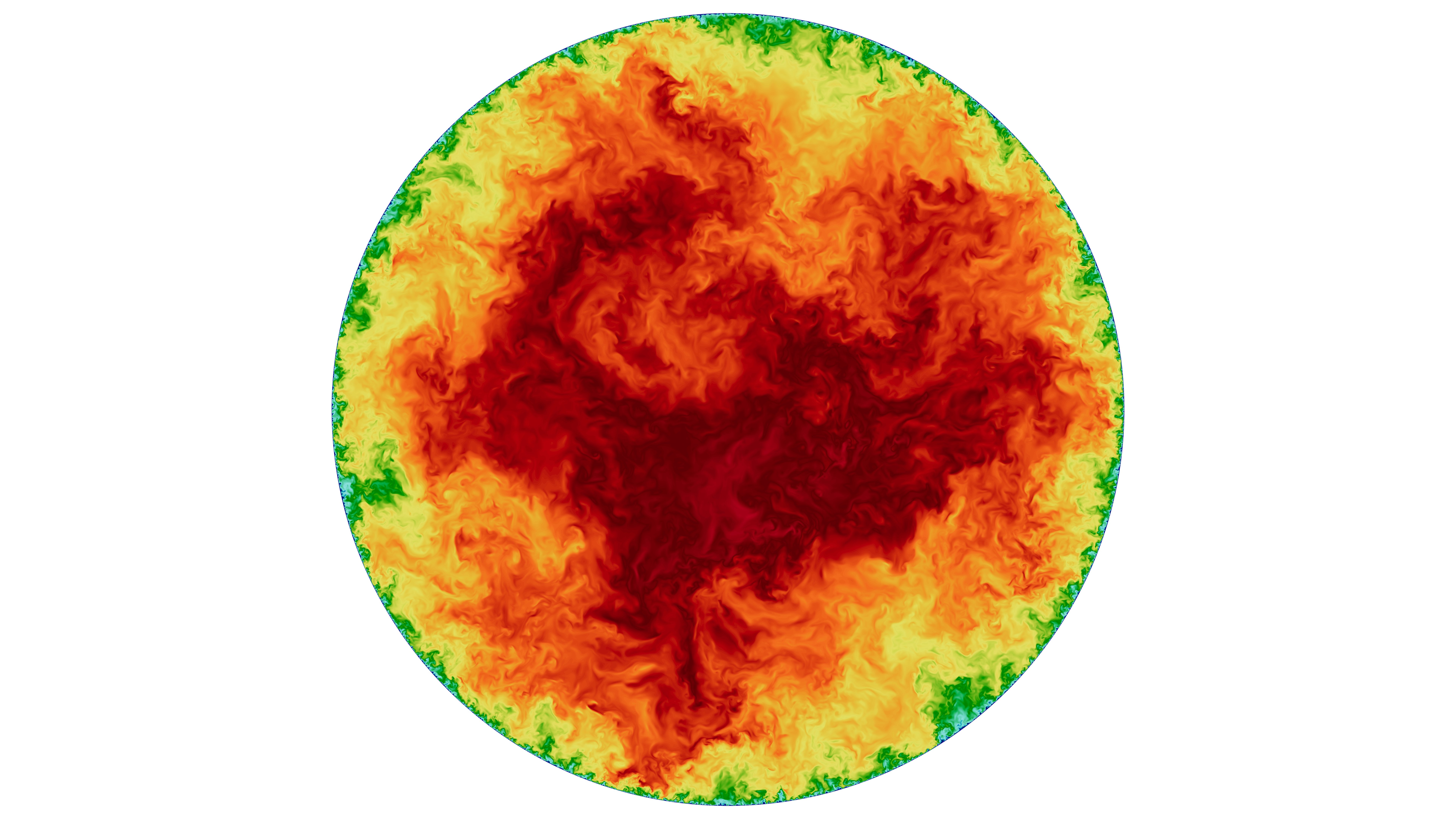ERCOFTAC PC Germany South
Fractal Patterns in High-Reynolds Number Turbulent Pipe Flow
Daniele Massaro
(Department of Mechanical Engineering, Massachusetts Institute of Technology (MIT), MA, USA)
Jie Yao
(Advanced Research Institute of Multidisciplinary Sciences, Beijing Institute of Technology (BIT), China)
Saleh Rezareiravesh
(Department of Mechanical & Aerospace Engineering, The University of Manchester (UoM), UK)
Fazle Hussain
(Department of Mechanical Engineering, Texas Tech University (TTU), TX, USA)
Philipp Schlatter
(Institute of Fluid Mechanics (LSTM), Friedrich-Alexander-Universität (FAU) Erlangen-Nürnberg, Germany)

Turbulence in pipe geometries governs everything from industrial pipelines to aspects of blood circulation, yet its multiscale complexity remains one of the last unsolved problems in classical physics. This visualization shows a snapshot of the instantaneous axial velocity component, seen in a cross-sectional plane. It is obtained through large-scale direct numerical simulation at a very high Reynolds number even for current supercomputers, and unveils the intricate interplay of low- and high-speed events of different sizes and locations in the pipe. Understanding, predicting and potentially controlling these patterns is key to enhancing energy efficiency, reducing drag, and driving innovations in aerospace, engineering, and beyond.
Scientific abstract
High-Reynolds-number turbulence remains a major challenge due to the complexities of modeling, prediction, and scaling of turbulence statistics. In particular, understanding the interactions between large-scale motions (LSMs), very-large-scale motions (VLSMs), and near-wall structures remains an active area of research, explored through experiments, theory, simulations, and data-driven analysis. One of the possible tools to study wall turbulence is via large-scale direct numerical simulations (DNS): This approach resolves all scales in both space and time on a fine numerical grid. For pipe flows of practical relevance, this approach is however extremely costly due to the high Reynolds numbers necessary for reaching sufficient scale separation between the smallest near-wall structures and the mentioned larger-scale motions. In this work, we investigated LSMs and VLSMs in smooth circular pipe flow. Using high-resolution DNS we investigated a series of cases up to a friction Reynolds numbers up to =10,000, using more than 60 billion grid points [1,2]. The simulations were performed using the 𝑅𝑒τhigh-order code OpenPipeFlow by Willis (2017).
This visualization shows instantaneous streamwise velocity in a cross-stream plane. It unveils the intricate interplay of low- and high-speed events (blue and red, respectively) of different sizes and locations across the pipe cross section. The well-known velocity streaks are visible in blue very close to the wall, with an approximate size of about 10 turbulent viscous units, corresponding to about one promille of the pipe radius only. At the same time, the largest structures scale directly with the pipe radius [1,3]. Apart from the physical relevance of turbulent wall-bounded flows at high Reynolds numbers, the fine fractal patterns of the turbulence are of stunning beauty, and reminds us of the complexity of the chaotic processes even in canonical flow cases.
In order to find an objective way to characterize these different scales, we performed Proper Orthogonal Decomposition (POD) analysis to quantify the spatial organization of turbulent structures [3]. These results provided valuable insights into the modal structure of turbulence and its large-scale dynamics. The statistical and structural analysis has enhanced our understanding of energy transfer within modal space, shedding light on the sustenance processes in wall-bounded turbulence. Specifically, a high-Reynolds-number dataset from direct numerical simulations (DNS) provides a valuable resource for modeling turbulent pipe flows, ranging from Reynolds-averaged Navier-Stokes (RANS) equations to large-eddy simulations (LES). Additionally, the novel combination of modal decomposition and Voronoi analysis introduced a classification method that distinguishes between attached and detached eddies based solely on their energy contributions, eliminating the need for arbitrary thresholds or filtering. This energy-based framework allowed for the extraction and characterization of large- and very-large-scale motions.
[1] J. Yao, S. Rezaeiravesh, P. Schlatter & F. Hussain. Direct numerical simulations of turbulent pipe flow up to . 𝑅𝑒τ≈5200Journal of Fluid Mechanics, 956, A18, 2023
[2] P. Schlatter, J. Yao, D. Massaro, S. Rezaeiravesh & F. Hussain. Direct numerical simulation of turbulent pipe flow at 𝑅𝑒τ=10,000. Bulletin of the American Physical Society, 2023
[3] D. Massaro, J. Yao, S. Rezaeiravesh, F. Hussain & P. Schlatter. Energy-based characterisation of large-scale coherent structures in turbulent pipe flows. Journal of Fluid Mechanics, 996, A45, 2024
